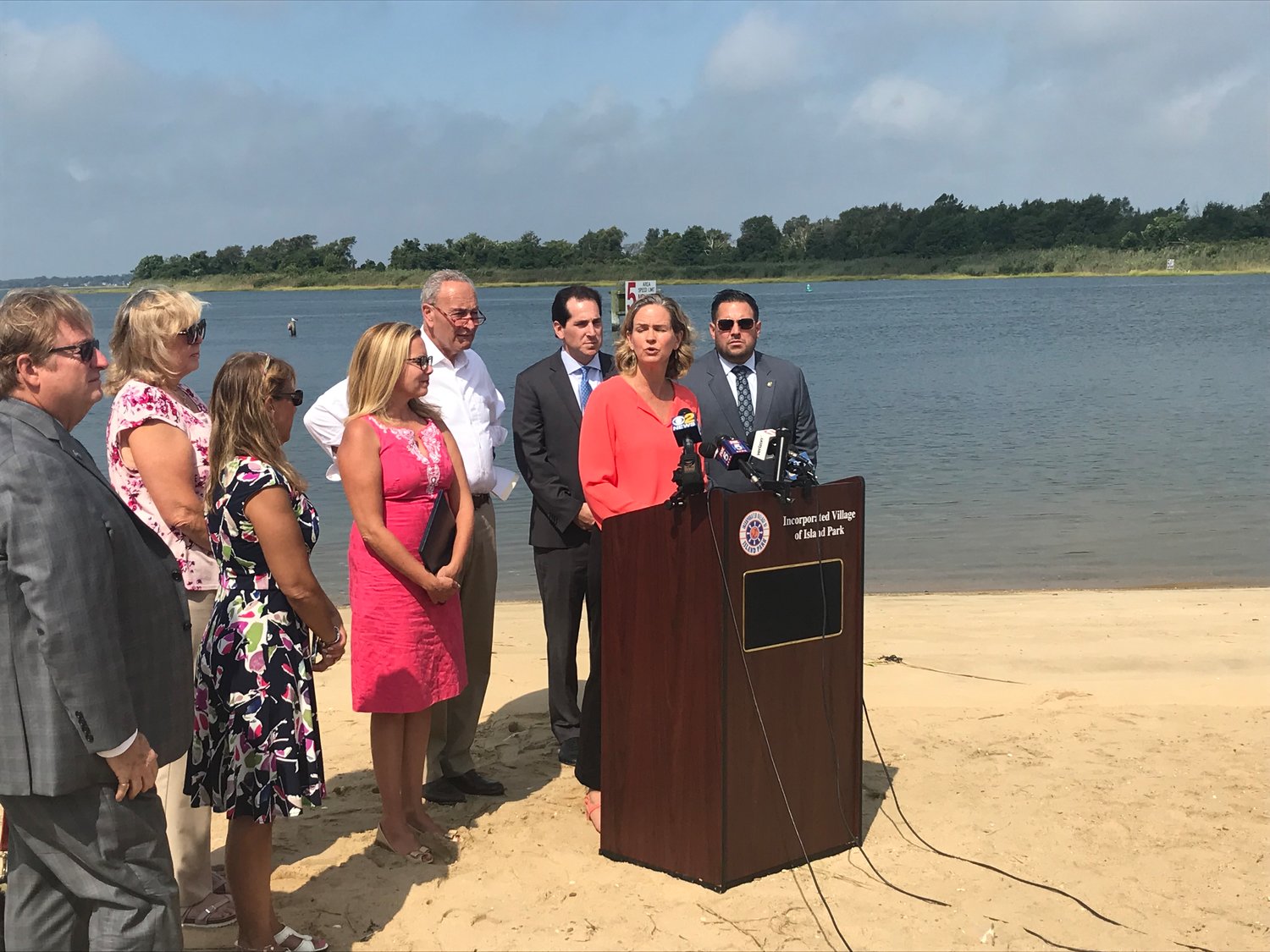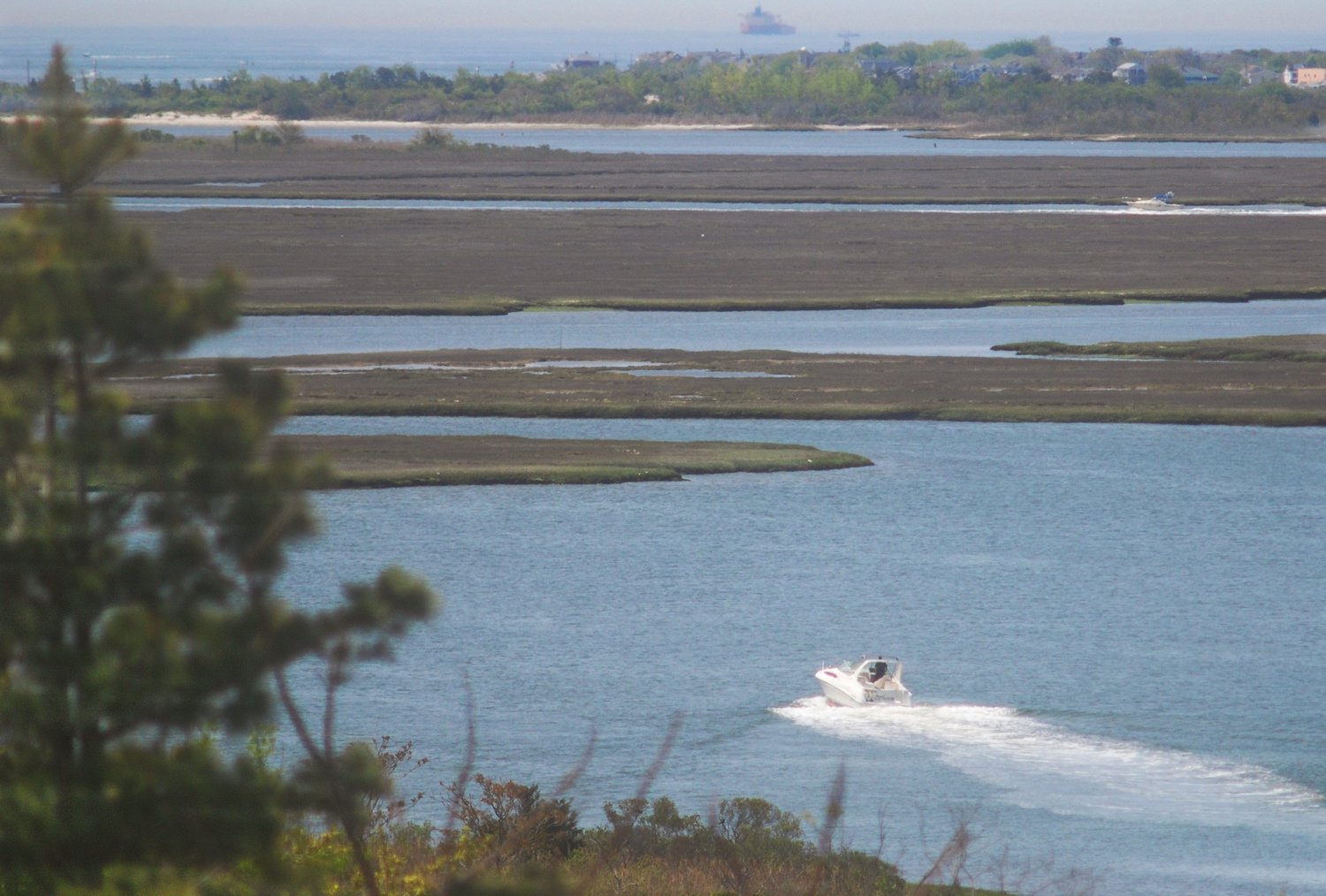Officials push Army Corps on back bays study that impacts East Rockaway
U.S. Sen. Chuck Schumer and several elected officials are urging the U.S. Army Corps of Engineers to approve a $6.1 million extension of the Nassau County Back Bays Coastal Storm Risk Management Study, which is set to expire on Sept. 30.
The study focuses on flood prevention for 30 miles along Long Island’s South Shore, including East Rockaway and Bay Park. At a Sept. 4 news conference on an eroded beach in Island Park, Schumer called on the Army Corps to sign an extension of the project, using money already allocated in the federal Hurricane Sandy relief fund.
“We’re in hurricane season, and that should be a reminder that we need to do everything we can to focus on what’s called resilience,” Schumer said. “Resilience means making sure things are protected before the hurricane comes, so when it comes, we won’t go through the horror that we went through with Sandy.”
In East Rockaway, many residents experienced that horror. Sandy forced several feet of saltwater into homes and businesses, sent sewage from the South Shore Water Reclamation Facility pouring into Bay Park residents’ homes and forced the East Rockaway Junior-Senior High School to close for several months.
Mayor Bruno Romano said he strongly supported extending the study to further examine ways to improve the ecology of the back bays, and noted that Hurricane Dorian was a reminder of the perils residents faced during Sandy.
“Further study can only help to improve the quality of life for current and future generations,” Romano said. “With Hurricane Dorian making landfall here in the United States, it gives us a stark reminder of how important it is for the Army Corps of Engineers to continue their work and find solutions to protect our communities from storms and rising sea levels.”
Romano added that work has gone into studies to improve the environment and that steps such as lowering the nitrogen content of the South Shore’s waterways would help marine life to flourish and harden the shore’s defenses against flooding and erosion.
In 2016, the Army Corps invested $3 million on the three-year examination of bulkheading, drainage, tidal gates and other flood control projects for coastal communities. The Army Corps’ Philadelphia district is handling the study.
Scott Sanderson, the project manager for the U.S. Army Corps of Engineers, said that because of the size and complexity of the study, the Philadelphia district submitted an extension request to Army Corps headquarters in Washington, D.C. He added that they also need approval from the assistant secretary of the Army for Civil Works.
The corps’ standard policy is to complete projects in three years or less for $3 million or less, but Sanderson said the district needs an extension given the size of the area being examined. The Army Corps and the New York State Department of Environmental Conservation handled the funding. “We have submitted a request for an exemption from the three-year study requirement and are awaiting the results of that process,” Sanderson said.
But time is running out, with a Sept. 30 deadline approaching. Because there are hundreds of thousands of people living on the South Shore and several elements that go into the examination, such as which direction potential hurricanes would come from and other logistics, it has taken longer than expected. The Army Corps has spent three years studying how to shield Nassau’s coastal communities from surges, floods, wind damage and erosion, but Schumer said it could all be for nothing if the study expires.
“All of that could erode away if we don’t act fast,” he said. “Our critical efforts to protect Nassau’s back bay communities from hurricanes and storms could drown in bureaucracy, unless the Army Corps acts.”
The study would likely take another three years if extended; however, the timetable could change given its scope. Funding includes a wide range of projects, such as flood barriers and simulations of future storms across the 30 miles of shoreline. Potential solutions that have been proposed to combat future storms include floodwalls, levees, surge barriers, cross bay barriers and “living shorelines” — protected coastal edges made from plants or rocks.
Schumer appeared at the Sept. 4 news conference alongside Island Park Mayor Michael McGinty, State Sen. Todd Kaminsky, Nassau County Executive Laura Curran, Hempstead Town Supervisor Laura Gillen, Hempstead Town Councilman Anthony D’Esposito, State Assemblywoman Melissa Miller and County Legislator Denise Ford.
Kaminsky said that rising sea levels and severe storms would continue to harm the South Shore in the future, and that measures must be taken soon to ensure that a storm similar to Sandy does not devastate the area again.
“We know what we have to do,” Kaminsky said. “We all learned the hard way. These houses had water up to their kitchen countertops. . . . We need to live in a resilient world, and that world is going to be created by this back bays study. It must get completed.”
Gillen said the study focuses mostly on the Town of Hempstead, which has 150,000 structures and $100 billion in damageable assets. She added that the devastation that Dorian wrought on the Bahamas underscores the need to complete the study.
“The importance and urgency of getting through this project should be obvious to the Army Corps,” she said. “The consequences of cutting and running before the mission is complete could be disastrous to the many families who live here on the South Shore of Nassau County and in the Town of Hempstead.”
Curran said it would be a waste of time, resources and research to give up on the study after three years of effort. “It makes me very sad to think that all of that intelligence and all of that work will just come to a grinding halt,” she said.
The extension would give the Army Corps until April 2022 to release its final report. At that point, the findings would be submitted to Congress for review. Sanderson said he was uncertain how long Congress would take to approve the study.










